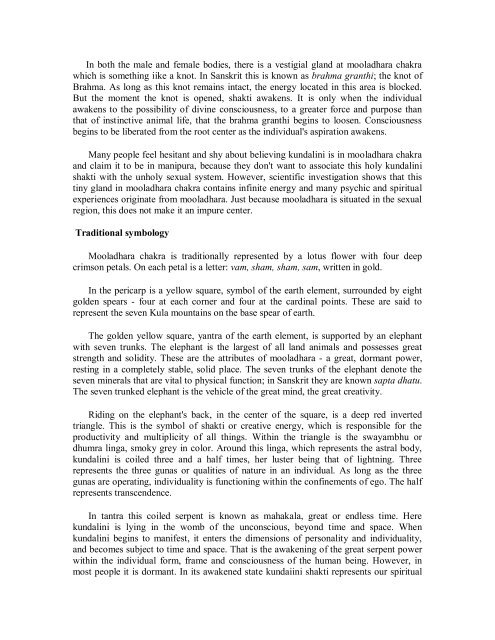Kundalini.Tantra.by.Satyananda.Saraswati
You also want an ePaper? Increase the reach of your titles
YUMPU automatically turns print PDFs into web optimized ePapers that Google loves.
In both the male and female bodies, there is a vestigial gland at mooladhara chakra<br />
which is something iike a knot. In Sanskrit this is known as brahma granthi; the knot of<br />
Brahma. As long as this knot remains intact, the energy located in this area is blocked.<br />
But the moment the knot is opened, shakti awakens. It is only when the individual<br />
awakens to the possibility of divine consciousness, to a greater force and purpose than<br />
that of instinctive animal life, that the brahma granthi begins to loosen. Consciousness<br />
begins to be liberated from the root center as the individual's aspiration awakens.<br />
Many people feel hesitant and shy about believing kundalini is in mooladhara chakra<br />
and claim it to be in manipura, because they don't want to associate this holy kundalini<br />
shakti with the unholy sexual system. However, scientific investigation shows that this<br />
tiny gland in mooladhara chakra contains infinite energy and many psychic and spiritual<br />
experiences originate from mooladhara. Just because mooladhara is situated in the sexual<br />
region, this does not make it an impure center.<br />
Traditional symbology<br />
Mooladhara chakra is traditionally represented <strong>by</strong> a lotus flower with four deep<br />
crimson petals. On each petal is a letter: vam, sham, sham, sam, written in gold.<br />
In the pericarp is a yellow square, symbol of the earth element, surrounded <strong>by</strong> eight<br />
golden spears - four at each corner and four at the cardinal points. These are said to<br />
represent the seven Kula mountains on the base spear of earth.<br />
The golden yellow square, yantra of the earth element, is supported <strong>by</strong> an elephant<br />
with seven trunks. The elephant is the largest of all land animals and possesses great<br />
strength and solidity. These are the attributes of mooladhara - a great, dormant power,<br />
resting in a completely stable, solid place. The seven trunks of the elephant denote the<br />
seven minerals that are vital to physical function; in Sanskrit they are known sapta dhatu.<br />
The seven trunked elephant is the vehicle of the great mind, the great creativity.<br />
Riding on the elephant's back, in the center of the square, is a deep red inverted<br />
triangle. This is the symbol of shakti or creative energy, which is responsible for the<br />
productivity and multiplicity of all things. Within the triangle is the swayambhu or<br />
dhumra linga, smoky grey in color. Around this linga, which represents the astral body,<br />
kundalini is coiled three and a half times, her luster being that of lightning. Three<br />
represents the three gunas or qualities of nature in an individual. As long as the three<br />
gunas are operating, individuality is functioning within the confinements of ego. The half<br />
represents transcendence.<br />
In tantra this coiled serpent is known as mahakala, great or endless time. Here<br />
kundalini is lying in the womb of the unconscious, beyond time and space. When<br />
kundalini begins to manifest, it enters the dimensions of personality and individuality,<br />
and becomes subject to time and space. That is the awakening of the great serpent power<br />
within the individual form, frame and consciousness of the human being. However, in<br />
most people it is dormant. In its awakened state kundaiini shakti represents our spiritual














![[Lonely Planet] Sri Lanka](https://img.yumpu.com/59845622/1/169x260/lonely-planet-sri-lanka.jpg?quality=85)


